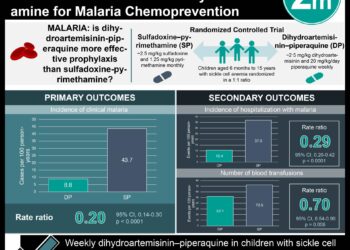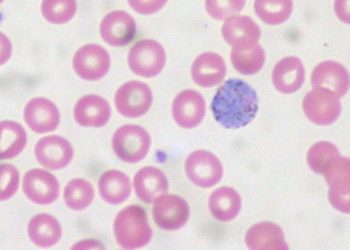2 Minute Medicine Rewind October 18 – October 25, 2015
Genetic Diversity and Protective Efficacy of the RTS,S/AS01 Malaria Vaccine
The RTS,S/AS01 vaccine is a monovalent recombinant protein vaccine that targets a fragment of the circumsporozoite protein parasite antigen for protection against Plasmodium falciparum malaria infection. Malaria has proven to be challenging for vaccine-development efforts around the world. The purpose of this study was to investigate whether the efficacy of the vaccine is specific to certain parasite genotypes at the circumsporozoite protein locus. The authors performed polymerase chain reaction sequencing of DNA taken from 4985 participants aged 5 to 17 months of age to identify polymorphisms in the circumsporozoite protein to determine vaccine efficacy against first episodes of clinical malaria within 1-year post vaccination. The authors found 1-year cumulative vaccine efficacy was 50.3% (95% CI, 34.6 to 62.3) against clinical malaria in which parasites matched the vaccine in the entire circumsporozoite protein C-terminal (139 infections), compared to only 33.4% (95% CI, 29.3 to 37.2) against control-vaccinated malaria (1951 infections); p = 0.04 for differential vaccine efficacy. Therefore there is significant difference in efficacy against malaria parasites with the matched circumsporozoite protein allele than against mismatched malaria. The proportion of matched alleles in the parasite population determines the overall vaccine efficacy and in this study less than 10% of parasites had matched alleles.
Time From Symptoms to Carotid Endarterectomy or Stenting and Perioperative Risk
The benefits of carotid endarterectomy or carotid artery stenting for symptomatic carotid artery disease decline with delay of treatment. Using the Carotid Revascularization Endarterectomy Versus Stenting Trial (CREST), the purpose of this study was to determine the difference in periprocedural stroke or death related to how quickly the carotid endarterectomy or carotid artery stenting was completed after symptom onset. Patients were classified into 3 groups based on time from symptoms to procedure: <15 days, 15 to 60 days, or >60 days. For patients who received carotid endarterectomy, there was no difference in risk of periprocedural stroke or death when comparing those who received the treatment 15-60 days after symptoms onset compared to < 15 days after symptom onset (hazard ratio, 0.74; 95% CI 0.22–2.49), or those who received the endarterectomy >60 days compared to <15 days (hazard ratio, 0.91; 95% CI 0.25–3.33). Comparing carotid artery stenting, the risk of periprocedural stroke or death was also not significantly different (hazard ratio, 1.12; 95% CI 0.53–2.40 for 15–60 days vs. < 15 days and hazard ratio, 1.15; 95% CI,0.48–2.75 for >60 days vs. < 15 days). Therefore early revascularization after symptom onset with either technique does not increase periprocedural safety.
Association Between Preeclampsia and Congenital Heart Defects
Preeclampsia is associated with poor outcomes if not quickly identified and promptly treated. The risk of congenital heart defects in babies of mothers who develop preeclampsia during their pregnancy is poorly understood. The objective of this population-level analysis in hospitals in Quebec, Canada was to determine the prevalence of critical or noncritical congenital heart defects in babies of women who developed preeclampsia during their pregnancy by analyzing the birth records from all women in Quebec from 1989-2012. They found the absolute prevalence of congenital heart defects was higher in women who developed preeclampsia (16.7 per 1000) compared to those mothers who did not develop preeclampsia (8.6 per 1000) (prevalence ratio 1.57; 95% CI 1.48 to 1.67). Although these babies were at higher risk of developing congenital heart defects they had no increased prevalence of critical heart defects (prevalence ratio 1.25; 95% CI 1.00 to 1.57). Prevalence was greatest for septal defects among all heart defects. When stratifying based on timing of preeclampsia, women who developed preeclampsia earlier than 34 weeks had a greater prevalence of critical heart defects (prevalence ratio 2.78; 95% CI 1.71-4.50) and noncritical heart defects (prevalence ratio 5.55; 95% CI 4.98-6.19). Therefore, the prevalence of preeclampsia was significantly associated with noncritical heart defects, however preeclampsia onset before 34 weeks was significantly associated with critical heart defects.
Naproxen With Cyclobenzaprine, Oxycodone/Acetaminophen, or Placebo for Treating Acute Low Back Pain
Low back pain is a frequent complaint seen in all emergency departments. The treatment algorithm for pain usually includes anti-inflammatory drugs, acetaminophen, opioids or skeletal muscle relaxants, often in combination. The objective of this randomized, double-blind study in the Bronx New York City was to compare outcomes at 1 week post discharge from the emergency department in patients treated with either naproxen + placebo, naproxen + cyclobenzaprine or naproxen + oxycodone/acetaminophen for their low back pain. Patients presenting with nontraumatic, nonradicular low back pain of 2 weeks’ duration or less were eligible for enrollment upon ED discharge if they had a score greater than 5 on the Roland-Morris Disability Questionnaire (RMDQ) in which 0 indicates no functional impairment and 24 indicates maximum impairment. Primary outcome was based on improvement in RMDQ at follow up compared to discharge. At discharge, the median RMDQ score in the placebo group was 20, in the cyclobenzaprine group 19, and in the oxycodone/acetaminophen group 20. At 1-week follow-up post discharge, the mean RMDQ improvement was 9.8 in the placebo group, 10.1 in the cyclobenzaprine group, and 11.1 in the oxycodone/acetaminophen group. Comparing between groups, difference in mean RMDQ improvement for cyclobenzaprine versus placebo was 0.3 (98.3% CI −2.6 to 3.2; P = .77), for oxycodone/acetaminophen versus placebo, 1.3 (98.3% CI −1.5 to 4.1; P = .28), and for oxycodone/acetaminophen versus cyclobenzaprine, 0.9 (98.3% CI −2.1 to 3.9; P = .45). Therefore adding cyclobenzaprine or oxycodone/acetaminophen to naproxen alone does not improve functional outcomes or pain at 1-week follow-up.
Resting heart rate, heart rate variability and functional decline in old age
Markers of an altered autonomic nervous system and subsequent development of atherosclerosis include elevated heart rate and reduced heart rate variability. There is a link between atherosclerosis and functional decline in the elderly from cardiovascular events, however it is unclear whether heart rate and heart rate variability are associated with functional decline, independent of cardiovascular disease. In order to address this hypothesis the authors obtained data from 5042 patients in the PROSPER study (Prospective Study of Pravastin in the Elderly at Risk). Data on heart rate and heart rate variability were collected from electrocardiograms (ECGs). Variability in heart rate was defined as the standard deviation of normal-to-normal RR intervals (SDNN) on the ECGs. Functional status was defined by activities of daily living (ADL) and instrumental ADL (iADL). The authors found that higher heart rate was associated with less independence on ADL and iADLs. Subsequently lower SDNN was associated with worse iADLs. More specifically, those in the highest heart range (71-117 bpm) had a 1.79-fold (95% CI 1.45– 2.22) and 1.35-fold (95% CI 1.12–1.63) higher risk of decline in ADL and IADL. Those patients in the lowest range of SDNN (range 1.70–13.30 ms) had 1.21-fold (95% CI 1.00–1.46) and 1.25-fold (95% CI 1.05–1.48) higher risk of decline in ADL and IADL. Therefore the authors found elevated heart rate and reduced heart rate variability were both associated with worse functional status in the elderly. It is important to identify these individuals at high risk and intervene to reduce their risk of functional decline over time.
Image: PD
©2015 2 Minute Medicine, Inc. All rights reserved. No works may be reproduced without expressed written consent from 2 Minute Medicine, Inc. Inquire about licensing here. No article should be construed as medical advice and is not intended as such by the authors or by 2 Minute Medicine, Inc.






